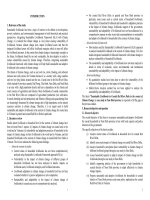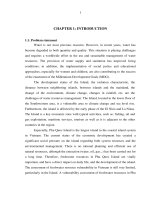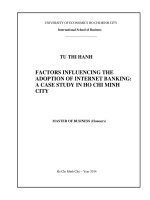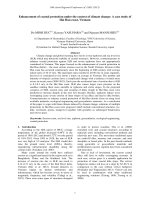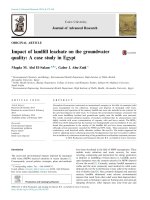Calculating design flood under the context of climate change - a case study in the south central and central highlands area
Bạn đang xem bản rút gọn của tài liệu. Xem và tải ngay bản đầy đủ của tài liệu tại đây (563.31 KB, 7 trang )
Calculating design flood under the context of climate change a case study in the south central and central highlands area
Ngo Le Long1*, Le Thi Hai Yen1, Ngo Le An1
Abstract: Currently, under the impact of climate change (CC), the phenomenon of extreme and againstthe-order-of-nature weather appears more and more. Floods often occur suddenly, causing a great deal
of damage to people and property. The South Central and Central Highlands have short and steep terrain
and are also home to many small and medium reservoirs subjected to direct changes from the flow
variation. There have been many studies and reports on the impacts of climate change on heavy rainfall
in the area. However, there is some uncertainty between the results due to differences in input models,
scenarios and destabilization methods. The paper focuses on assessing and analyzing the change of
maximum rainfall in the South Central and Central Highlands under the average climate change
scenarios (RCP4.5) and high climate change scenarios (RCP8.5) using different global climate models
(GCM). The variation among the models (in percentile 25 to 75 percent) varied from 10 percent to 50
percent, indicating the uncertainty in the rainfall simulation of each GCM. As a result, flood simulation
from the rainfall will be different according to the different climate models. The proposed report on the
creation of zoning maps of design flood variation under the impact of climate change is based on the
"consensus" of trends among GCM models. Based on that, the design floods in the basins in each region
will be adjusted accordingly to ensure the safety and economics of the works
Keywords: Design flood, climate change, global climate model, statistical details.
1. Introduction *
Design flood estimation has been one of the
important tasks of hydrological science from the
early days, which is an integral part of the design
and assessment of reservoir safety. In recent years,
under the impact of climate change, the
hydrological regime in many parts of the world
has been changing. The phenomenon of extreme
and against-the-order-of-nature weather appears
more and more. Floods occur frequently and
continuously cause great damage to people and
property. The South Central and Central
Highlands have short and steep terrain and also
have many small and medium basins which are
subject to direct changes from the flow variation.
Although there have been many studies and
1
Thuyloi University, 175 Tayson Street, Hanoi, Vietnam
* Corresponding author
Received 26th May 2022
Accepted 9th Jun. 2022
Available online 31st Dec. 2022
reports on the impacts of climate change on heavy
rainfall in the area, there is some uncertainty
among research results due to differences in input
models, the use of scenarios and destabilization
method, resulting in the variations of simulated
flood flows among different climate models (An
et al., 2015; Trần Thị Tuyết et al., 2018; Hằng,
Dương and Đơn, 2020). The paper focuses on
assessing and analyzing the change in maximum
daily rainfall for the South Central and Western
Highlands according to medium (RCP4.5) and
high climate change (RCP8.5) scenarios using
different global climate models (GCM). Then, the
study proposes a "potential change" in the peak
flow map based on the "agreement" of the trends
between the outcomes of each model under the
different scenarios into 3 groups: "high
increasing", "medium increasing" and "no
change". Based on that, design floods in the basins
in each region will be adjusted accordingly to
ensure the safety and economics of the project.
Journal of Water Resources & Environmental Engineering - No. 82 (12/2022)
25
2. Research methodology
For the South Central Region in particular and
Vietnam in general, the cause of floods is mainly
due to heavy and prolonged rain. Therefore,
precipitation is the most considerable factor to
estimate design floods for the South Central
region. Criteria of design peak flood estimation
for the ungauged basin in Vietnam (depending on
the area of the basin) are given below:
For basins with an area is less than 100
km2: apply the G.A. Alexeyev's formula
(Alexeyev, 1967).
For basins with an area of is in between
100 km2 and 1000 km2: Using the Sokolovsky's
formula (Sokolovsky, 1968).
For larger basins: Estimated from similar
basins by an empirical reduction formula.
Within the scope of the study, the paper
carried out design flood calculations with
consideration of climate change for small and
medium river basins. In this case, the greatest
daily rainfall would be the most important input
to determine the flow of floods. The simulated
rainfall data is derived from 11 global climate
models, used by the Intergovernmental Panel on
Climate Change (IPCC) in climate change
reports (IPCC, 2013) with two climate change
scenarios, namely RCP4.5 and RCP8.5.
Detailed information of the models is presented
in Table 1.
Table 1. Global climate models used in the study
No
1
2
3
4
5
6
7
8
9
10
11
Models
ACCESS 1.3
CanESM2
CMCC-CMS
CNRM-CM5
CSIRO-MK3.6
FGOALS-g2
GFDL-ESM2G
HadGEM2-CC
IPSL-CM5A-MR
MIROC5
MPI-ESM
Institutions
Bureau of Meteorology
Climate Modeling and Analysis Center
Mediterranean Center for Climate Change
National Center for Meteorological Research
Federal Institute for Science and Industry
Institute of Atmospheric Physics, Institute of Science
Laboratories of geophysical dynamics
Met Office Hadley Center
Institute of Pierre Simon Laplace
Institute of Atmospheric and Oceanic Studies
Max Planck Institute of Meteorology
Observed rainfall data of 93 stations located
in the South Central and Central Highlands are
used to describe the precipitation condition in
local. The data series are taken from the
beginning of observation in each station until
2005 (the end of the historical simulation of the
climate models), which is also considered as the
baseline period for evaluating the variations of
climate in the future. The missing and abnormal
data of each station is analyzed to evaluate and
adjust accordingly. The station network used in
the study is depicted in Figure 1.
Observed precipitation at 93 stations in the
26
Countries
Australia
Canada
Italy
France
Australia
China
America
England
France
Japan
Germance
Resolution
1,875o x 1,25o
2,81o x 2,79o
1,875o x 1,865o
1,40o x 1,40o
1,875o x 1,865o
2,81o x 2,79o
2,50o x 2,00o
1,875o x 1,25o
2,50o x 1,268o
1,40o x 1,40o
1,875o x 1,865o
area was used to correct the bias of GCM models.
The method for bias correction is to find a
function h in which, when plotting the simulated
variable Pm, its new distribution function
corresponds to the distribution of the observed
variable Po (where Pm and Po are the simulated
rainfall and observed rainfall). This transforming
function can be represented by the formula:
Po = h(Pm)
(1)
Statistical transforming functions are an
application of the inverse integral of the
probability distribution, and if the distribution of
the variables is known, the transforming
Journal of Water Resources & Environmental Engineering - No. 82 (12/2022)
function is defined by Ines and Hansen, (2006)
and Piani et al, (2010):
(2)
Where Fm is the cumulative probability
distribution of Pm and
is the cumulative
inverse function corresponding to Po.
3. Results and discussion
3.1. Bias correction evaluation
Figure 2 shows the mean error (a) and the
standard deviation error (b) between the results
of the simulation of the maximum daily
precipitation of the 11 models and measured
results in the study area. For each model, the
white box on the left represents the error
between the unbias value and the measured one,
and the blue box on the right represents the error
after the bias correction process. The boxes
represent the variable ranges corresponding
from 25% to 75%. Dashes between boxes show
average values.
Figure 1. Map of the areas and stations
used in the study
The results of the daily precipitation
simulated from the 11 global climate models
will be corrected the bias by applying the
formula (1) for each station in the area.
According to the Alexeyev and Xokolopski
formulas, the design peak discharge taking into
account climate change depends on the
changing of the maximum daily precipitation in
the future. From these two calculations, it can
be seen that the rate of change of future design
peak discharge will be equal to the change in the
maximum daily precipitation with the
assumption of other features of the basin and the
relationship between short-term precipitation
and unchanged daytime rainfall.
Figure 2. The average (a) and standard
deviation (b) of the difference between the
maximum daily precipitation of 11 GCM
models with observed data at 93 rainfall
stations in the study area
The results show that the precipitation in the
past was simulated with a remarkably consistent
local condition after bias correction. Before the
correction, the difference between the mean and
standard deviation of the maximum daily rainfall
of the model was very large. The maximum daily
rainfall is generally smaller than the observations
Journal of Water Resources & Environmental Engineering - No. 82 (12/2022)
27
from 50mm to 150mm, especially in cases of
variation of up to 250mm as in CSIRO-QCCCE,
CMCC-CMS, IPSL models.
After the bias correction, the average
maximum daily rainfall (on the average of 93
stations) of the models was approximately equal
to the actual measurement (within ± 5 mm).
Similarly, mean standard deviation values have
also been improved from -10 mm to -70 mm
difference to ± 5 mm (in percentile 25 to 75
percent). The CMCC-CMS, CNRM-CM5,
FGoals, HadGEM2 models exhibit a good fit at
both the mean and standard deviation of the
maximum daily rainfall series. The CSIROQCCCE model shows the worst results when
both the mean error and the standard deviation
error are still significantly lower than the real
ones after correcting the error.
3.2. The development of the changing maximum
daily precipitation map of the study area
The calculation results of the maximum daily
precipitation from the 11 global climate models
for the two phases of 2040-2069 and 2070-2099
are used to develop the maximum daily
precipitation map in the South Central Region
by two scenarios RCP4.5 and RCP8.5.
Figure 3. Map of the largest daily change in rainfall (%) according to scenarios
28
Journal of Water Resources & Environmental Engineering - No. 82 (12/2022)
From the results of the maximum daily
precipitation (Figure 3), it can be seen that in the
scenario RCP4.5 phase 1 (2040-2069), most of
the models show an increasing trend of rainfall
compared to the base period, with an increase by
from 0% to 20%. Results of the average rainfall
calculation compared with the baseline from 11
models, generally in the South Central area, have
an upward trend with a common increase from 010%. In the second period (2060 - 2099) for
RCP4.5 scenarios, the average rainfall is likely to
increase compared to the first period, with the
typical increase of 20-30% except for Chu Prong
station in Gia Lai. Scenario RCP8.5 in both
phases tends to have similar trends to RCP4.5
with an average increase of 10-20% in period 1
and 20-30% in period 2.
To clarify the changes, the study focuses on
analyzing the maximum daily precipitation
changes of some major areas compared to the
baseline including the whole zone, Vu Gia Thu
Bon (VGTB), Tra Khuc (TK), Cai River (Cai), Ba
River, Kone, Sesan and Srepok. Accordingly, the
average daily rainfall variation in each basin is
represented by a box representing 25 to 75 percent
of the 11 models. The dashes in each box
correspond to 50%, while the diamonds
correspond to the mean. The stripes are extended
to a range of 1.5 times the spacing between the top
and bottom of the box. The external (+) signs
represent exceptional values. The results show
that the maximum daily precipitation variations in
the areas are as follows: Except for scenario RCP
4.5 simulating the first period for the maximum
daily precipitation in which there is a large
difference in rainfall from the baseline, most
models generally show a significant increase in
rainfall in the basins despite remarkable
differences between models. The variation
between the models (in the 25 to 75 percent range)
fluctuates from 10% to 50% (especially in the
Srepok River Basin), which demonstrates
uncertainty in the rainfall simulation of each GCM
model. On the other hand, many models show the
greatest reduction in average daily rainfall in the
Ba, Kone, Srepok and Cai basins, although the
rainfall in these basins increases on average
(Figure 4).
Figure 4. Average variations of largest one-day rainfall in some major river basins compared to the baseline
Journal of Water Resources & Environmental Engineering - No. 82 (12/2022)
29
3.3. Develop a risk map of increasing design
peak discharge for small and medium basin
From the results of calculating the maximum
daily precipitation under the climate change
scenarios, it can be seen that future flood flows will
also have the same change when using the
Xokolopski and Alecxayep. Fluctuations in peak
discharge also indicate that there is a difference
between GCMs and even contradictory increases or
decreases in intensity. To simplify the selection of
the design, the study recommends the criteria for
the classification of "potential change" for the
peak of flow as shown in Table 2. The general
criteria for zoning are based on the maximum
daily precipitation variability of each model and
the average of all 11 models, and also consider
the number of models "agreeing" with such
"general" variation.
Table 2. Criteria for Classification of "potential change" in peak of flow
Groups
3 (High Increasing)
2 (LowIncreasing)
1 (No change)
Number of models for
increased peak discharge
> 2/3
> 2/3
> 1/2
< 1/2
Based on the criteria in Table 2, the study
establishes "changing of the peak of flow" based
on the maximum daily precipitation change for
two periods: 2040–2069 and 2070 – 2099 (Figure
5). To apply this map when calculating design
floods for basins within the scope of the map, it is
important to depend on the area of the basin and
the importance of the constructions for making
reasonable choices. For example, if the basins for
Qmax change of
average GCM
models
>10%
>10%
>0
The change of
average coefficient of
variation
>=0
<0
>=0
calculation are small and located in the areas
corresponding to the design flood peak which is
likely to increase more than the base period, after
calculating the design flood flow according to the
mentioned methods, this design flood flow can be
added a safety factor of 10%. Likewise, for areas
where the increased design flood flows are little, a
safety factor of 5% may be obtained. With the
"No change" area, the calculation results are kept.
Figure 5. Zoning map of design flood flow fluctuations in 2040 - 2069 period (left)
and 2070 - 2099 period (right)
30
Journal of Water Resources & Environmental Engineering - No. 82 (12/2022)
4. Conclusions
The study used data from 93 regional rainfall
stations and simulation results of 11 global
climate models. The report has been biascorrected between simulation results from the
GCM model and measured data in stations in
the base period using the empirical quantile
mapping method. The results showed that the
bias correcting step reduced the errors in the
simulation of the model.
From the correcting of simulation results of
the future rainfall according to the 11 models,
the inverse distance weight interpolation method
is used to describe the precipitation to generate
maps of the maximum daily rainfall variations
in the future for the entire study area. The
output results of the average rainfall compared
to the baseline from the 11 models of the first
period (2040-2069) show that in general, the
South Central region witnessed an upward trend
with a common increase of 10-20%, and 2030% in the second period (2070-2099) under
both scenarios RCP4.5 and RCP8.5.
The study compiled the criteria for the
classification of "potential change" in peak
discharge based on the changes in the maximum
daily precipitation of each model and the
average of 11 models. Then a risk map for flood
variation taking into account climate change is
generated for small and medium basins. Based
on the maps, the future design flood estimation
should be considered.
References
Alexeyev, G. A., “Objective statistical methods of
computation and generalization of the
parameters of maximum rainfall runoff”.
Proceedings of the Leningrad Symposium on
Floods and their Computation, 1967.
An, N.L. et al. (2015) “Tính tốn lại lũ thiết kế
hồ chứa A Vương có xét đến tác động của
biến đổi khí hậu,” Journal of Water
Resources Science and Technology, 29,
pp. 1–6.
Ines AVM, Hansen JW, "Bias correction of daily
GCM rainfall for crop simulation studies,"
Agric For Meteorol 138 44-53, 2006.
IPCC, 2013: “Climate Change 2013: The
Physical Science Basis. Contribution of
Working Group I to the Fifth Assessment
Report of the Intergovernmental Panel on
Climate Change” [Stocker, T.F., D. Qin, G.-K.
Plattner, M. Tignor, S.K. Allen, J. Boschung,
A. Nauels, Y. Xia, V. Bex and P.M. Midgley
(eds.)].
Cambridge
University
Press,
Cambridge, United Kingdom and New York,
NY, USA, 1535 pp.
Hằng, N.T.M., Dương, V.H. and Đơn, N.C.
(2020) “Đánh giá ảnh hưởng của biến đổi khí
hậu đến an tồn hồ chứa nước Đá Bàn tỉnh
Bình Định,” Journal of Water Resources
Science and Technology, 62, pp. 114–120.
Piani, G.P. Weedon and others, "Statistical bias
correction of global simulated daily
precipitation and temperature for the
application of hydrological models," Journal of
Hydrology, Vol. 396 199-215, 2010.
Sokolovsky D.L.
River runoff. 3rd edition,
Hydrometeorological
Publishing
House,
Leningrad. 1968.
Trần Thị Tuyết et al. (2018) “Research on impact of
climate change on design flood in river basins in
Binh Dinh province,” Journal of Water
Resources & Environmental Engineering, 63,
pp. 111–119.
Journal of Water Resources & Environmental Engineering - No. 82 (12/2022)
31
